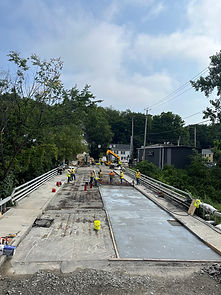



If you have surface spalling and concrete delamination of bridge decks, you need to perform:
Hydro-Blast Inlay for Bridge Deck Repair
Bridge decks are susceptible to surface spalling and deterioration of the concrete above the top mat of reinforcing steel. When this occurs, the most effective solution is to fully remove the damaged material and replace it with high-strength, often fiber-reinforced, repair materials.
The removal of compromised concrete is best accomplished using high-pressure waterblasting (hydro-blasting), which effectively chips away the deteriorated material to the desired depth without damaging the underlying structure. In many cases, engineers choose to hydro-blast the entire bridge deck to ensure a uniform and consistent repair surface across the structure.
Thorough cleaning of the hydro-blasted surface is critical to ensure proper bonding of the new repair material. Since fast-setting, high-strength materials can be challenging to place with a smooth finish, the International Grooving and Grinding Association (IGGA) recommends that diamond grinding be considered a necessary final step. This ensures the repaired deck meets ride quality and surface texture requirements.
Resources
Hydro-Demo Higher Performance Inlay (UHPC Overlay) for Bridge Deck Preservation
Bridge decks are often overlooked when it comes to highway preservation. Minor spalls and deteriorations can have a drastic impact on the life of a bridge deck, causing structural components beneath to prematurely corrode. Nick Davis of the International Grooving and Grinding association walks you through the process of a hydro-demo inlay, also known as a UHPC Overlay, by examining the Winter Street Bridge of Troy, NY.
Resource Type:
Resource Sections:
Resource Techniques:
Resource Issues:
Video
Bridge
Concrete Pavement Preservation and Restoration, Diamond Grinding, Diamond Grooving
Friction/Safety, Structural/Material Issues, Tire/Pavement Noise
Hydro-Demo Higher Performance Inlay (UHPC Overlay) for Bridge Deck Preservation
Bridge decks are often overlooked when it comes to highway preservation. Minor spalls and deteriorations can have a drastic impact on the life of a bridge deck, causing structural components beneath to prematurely corrode. Nick Davis of the International Grooving and Grinding association walks you through the process of a hydro-demo inlay, also known as a UHPC Overlay, by examining the Winter Street Bridge of Troy, NY.
Resource Type:
Resource Sections:
Resource Techniques:
Resource Issues:
Video
Bridge
Concrete Pavement Preservation and Restoration, Diamond Grinding, Diamond Grooving
Smoothness, Structural/Material Issues, Tire/Pavement Noise

